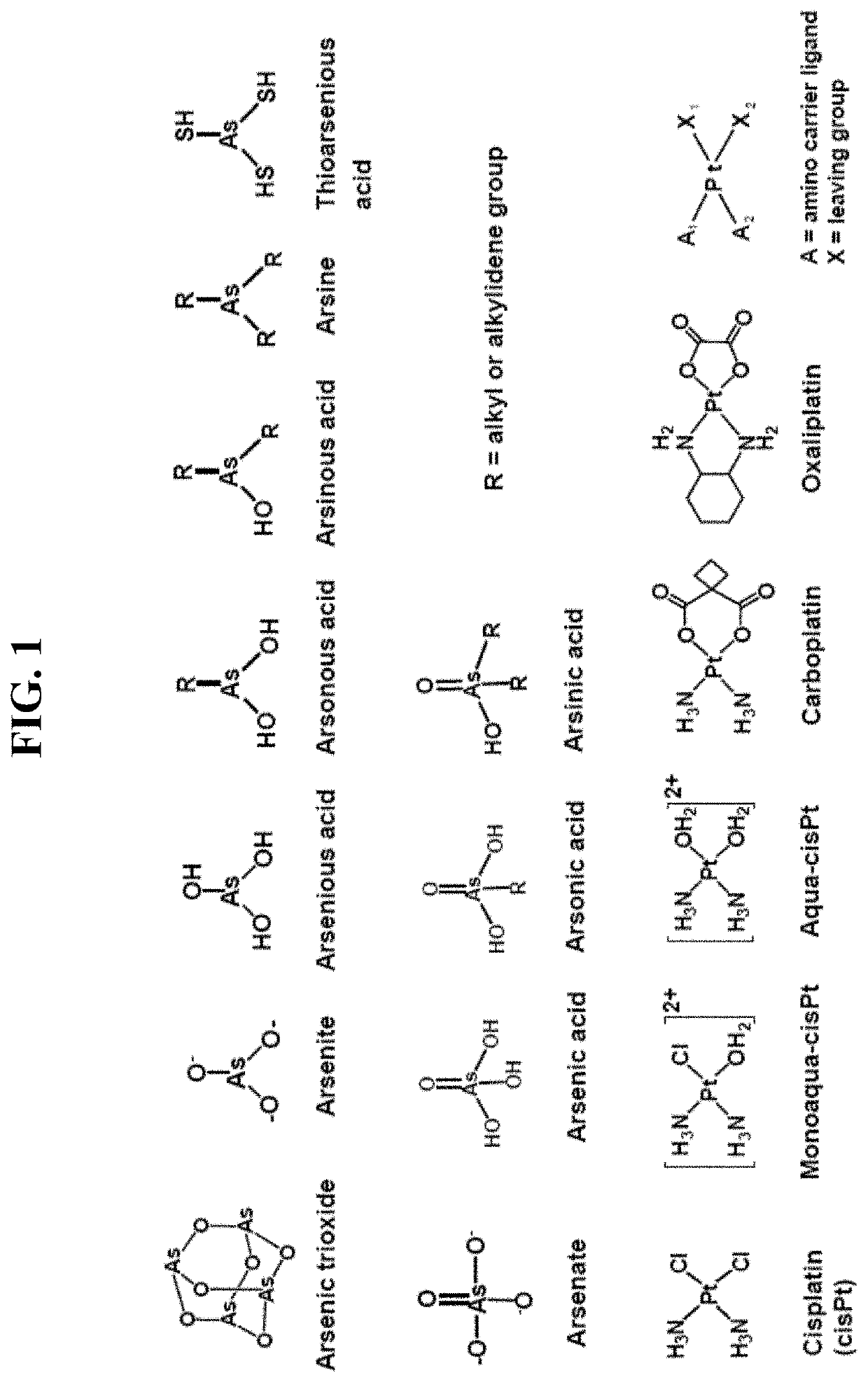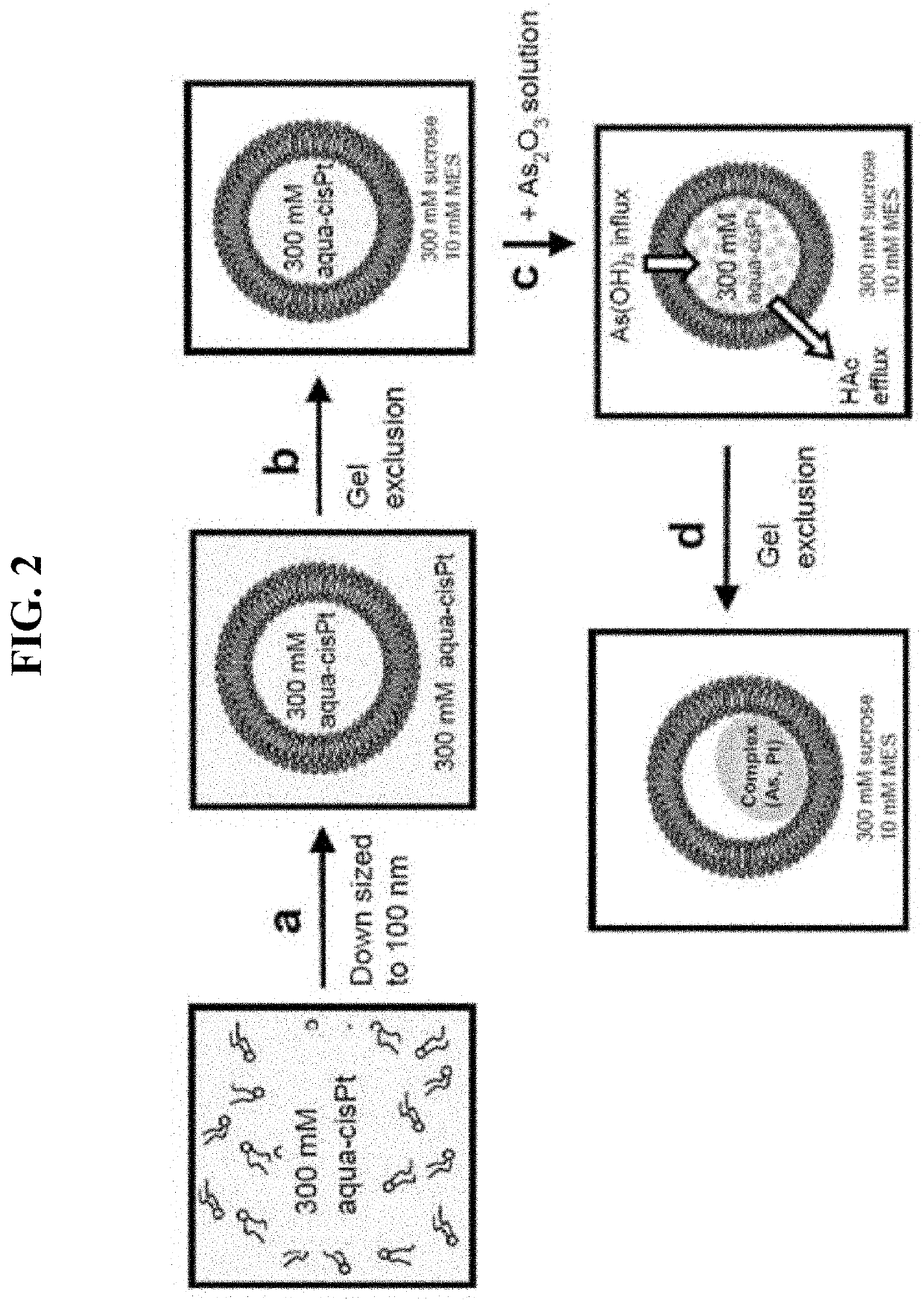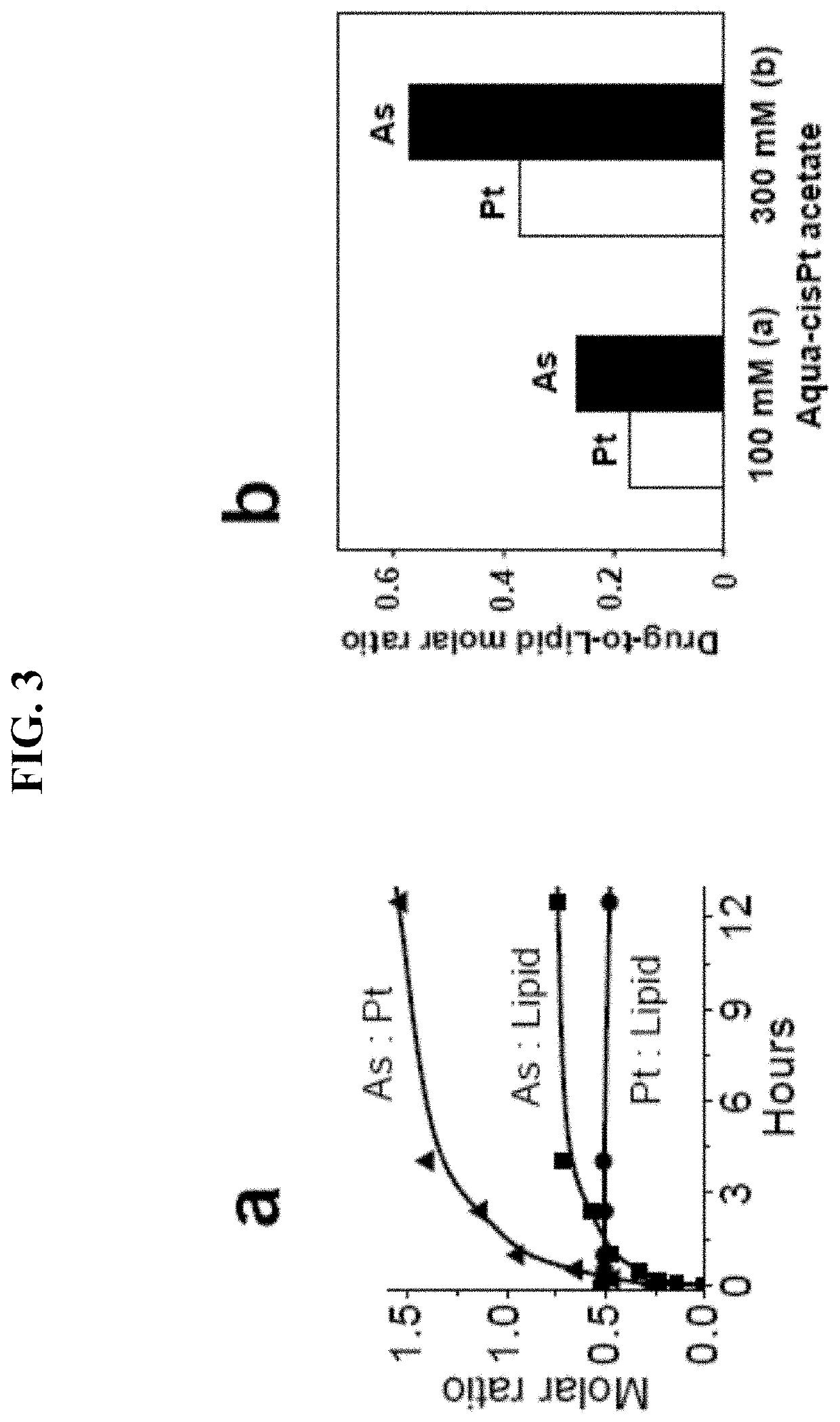Nanoparticle arsenic-platinum compositions
a technology of platinum composition and nanoparticles, which is applied in the direction of drug compositions, peptides/protein ingredients, peptides, etc., can solve the problems of limited broader therapeutic applications of cispt, poor clinical outcomes of as/sub>2/sub>3/sub>in solid tumors, and limited bioavailability, so as to achieve efficient and rapid loading of arsenic drugs
- Summary
- Abstract
- Description
- Claims
- Application Information
AI Technical Summary
Benefits of technology
Problems solved by technology
Method used
Image
Examples
example 1
Compositions and Methods
[0112]Materials. Dipalmitoylphosphatidylcholine (DPPC), dioleoylphosphatidylglycerol (DOPG) and 1,2-Dipalmitoyl-sn-glycero-3-phosphoethanolamine-N-(Lissamine rhodamine B sulfonyl) (ammonium salt) (DPPE-Rh) were purchased from Avanti Polar Lipids (Alabaster, Ala., USA). 1,2-Distearoyl-sn-glycero-3-phosphoethanolamine-N-[folate(polyethylene glycol)-3350] (DSPE-PEG3350-Folate) was synthesized according to the literature (Gabizon et al. Bioconjug. Chem. 1999, 10, 289-298., herein incorporated by reference in its entirety). Cholesterol (Chol), arsenic trioxide (As2O3), sodium arsenite (NaAsO2), cisplatin (cisPt), silver acetate (Ag(OAc)), folic acid (FA), paraformaldehyde, 2-[4-(2-hydroxyethyl)-1-piperazine]ethanesulfonic acid (HEPES), 2-[N-Morpholino]ethanesulfonic acid (MES), Bicine, sucrose, sodium dodecyl sulfate (SDS), phenazine methosulfate (PMS), human insulin solution, and Sephadex G50 were obtained from Sigma-Aldrich (St. Louis, Mo., USA). Sodium nitrate ...
example 2
Coencapsulation of Arsenic and Platinum Drugs within Liposomes
[0121]Preparation of aqua-cisPt gradients. The dried lipid film (DPPC / DOPG / Chol=51.4 / 3.6 / 45 mol %) was hydrated in 300 mM aqua-cisPt acetate (SEE FIG. 2A) to form multilamellar vesicles, which were further subjected to 7 freeze-and-thaw cycles (freezing in a ethanol / dry-ice bath and thawing in a water bath at 50° C.) (MacDonald et al. Biochim Biophys Acta 1994, 1191, 362-370., herein incorporated b reference in its entirety). The liposomes were then extruded with a manual mini-extruder (Avanti Lipids, Ala., USA), 10 times through two stacked polycarbonate filters of 0.1 μm pore size at ca. 40° C. Extruded liposomes in the aqua-cisPt acetate were then fractionated on Sephadex G-50 columns (1 mL sample volumes were placed on columns with at least a 20 mL column bed) equilibrated with the buffer of 300 mM sucrose (or NaNO3), 10 mM MES, pH 5.1 (SEE FIG. 2B).
[0122]Arsenic loading. Typically, for 30 mg of DPPC / DOPG / Chol, 51.4 / 3...
example 3
Preparation of Sterically Stabilized Arsenic and Platinum Liposomes
[0126]100 mg of dried lipid film of DSPC / DSPE-PEG2000 / DPPE-Rh / Chol 50.5 / 4 / 0.5 / 45 mol % was hydrated in 2.2 mL of 300 mM aqua-cisPt acetate at 55-60° C. for 1 h. This was subjected to 6 freeze-and-thaw cycles and then extruded 10 times through two stacked polycarbonate filters of 0.1 μM pore size at 40° C. After removal of extraliposomal platinum with Sephadex G-50 using a buffer of 150 mM NaNO3, 10 mM MES, pH 5.1, 340 μL of 300 mM As2O3 solution was added to these platinum-encapsulated liposomes (−6 mL), and the pH of mixture was adjusted to 7.2. This was incubated at 55° C. for 10 h with gently stirring. The mixture was then cooled down and passed through Sephadex G-50 with 300 mM sucrose, 20 mM HEPEs, pH 7.4 to remove unencapsulated arsenic and platinum species. The concentrations of lipids (P) and of encapsulated As and Pt in the excluded fractions (˜6.5 mL) were determined with an inductively coupled plasma optic...
PUM
 Login to View More
Login to View More Abstract
Description
Claims
Application Information
 Login to View More
Login to View More - R&D
- Intellectual Property
- Life Sciences
- Materials
- Tech Scout
- Unparalleled Data Quality
- Higher Quality Content
- 60% Fewer Hallucinations
Browse by: Latest US Patents, China's latest patents, Technical Efficacy Thesaurus, Application Domain, Technology Topic, Popular Technical Reports.
© 2025 PatSnap. All rights reserved.Legal|Privacy policy|Modern Slavery Act Transparency Statement|Sitemap|About US| Contact US: help@patsnap.com



